Accounting Fundamentals Report: Financial Position and Strategy
VerifiedAdded on 2023/03/17
|11
|1631
|46
Report
AI Summary
This report provides an overview of accounting fundamentals, including the creation and analysis of financial statements (balance sheet, profit and loss, and statement of changes in equity) for a company that has incurred a loss during the year. It explores various methods of depreciation (straight-line, reducing balance, sum of the years' digits, and units of activity) and inventory valuation (FIFO, LIFO, and weighted average), along with their respective advantages and disadvantages. The report also examines internal control mechanisms, such as segregation of duties, access controls, physical audits, documentation, trial balances, and account reconciliation. Finally, it concludes with recommendations for the company to improve its financial performance and future profitability, suggesting a focus on cost reduction, revenue enhancement, and the implementation of robust internal controls. The company is advised to use the written down value method of inventory.
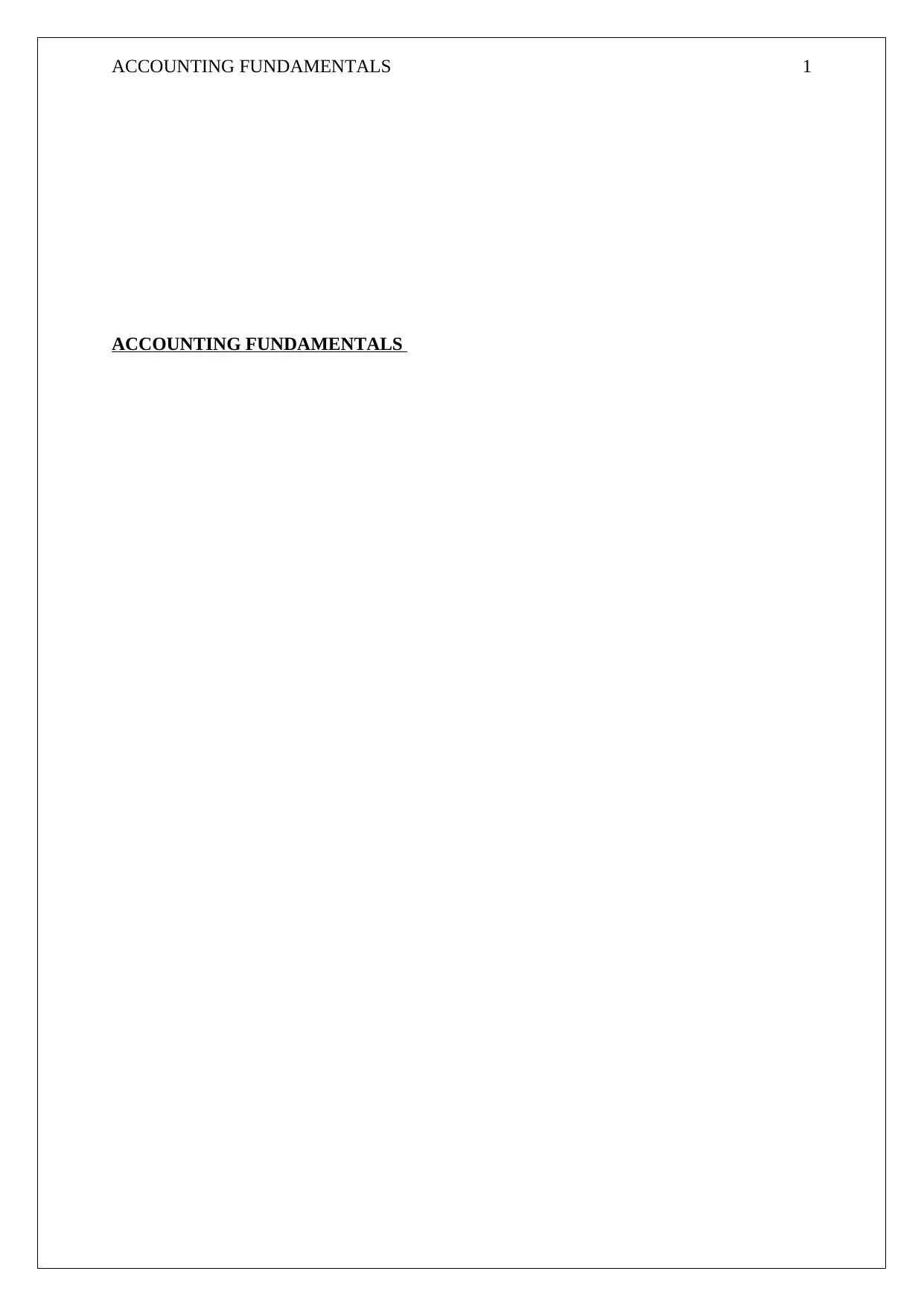
ACCOUNTING FUNDAMENTALS 1
ACCOUNTING FUNDAMENTALS
ACCOUNTING FUNDAMENTALS
Paraphrase This Document
Need a fresh take? Get an instant paraphrase of this document with our AI Paraphraser
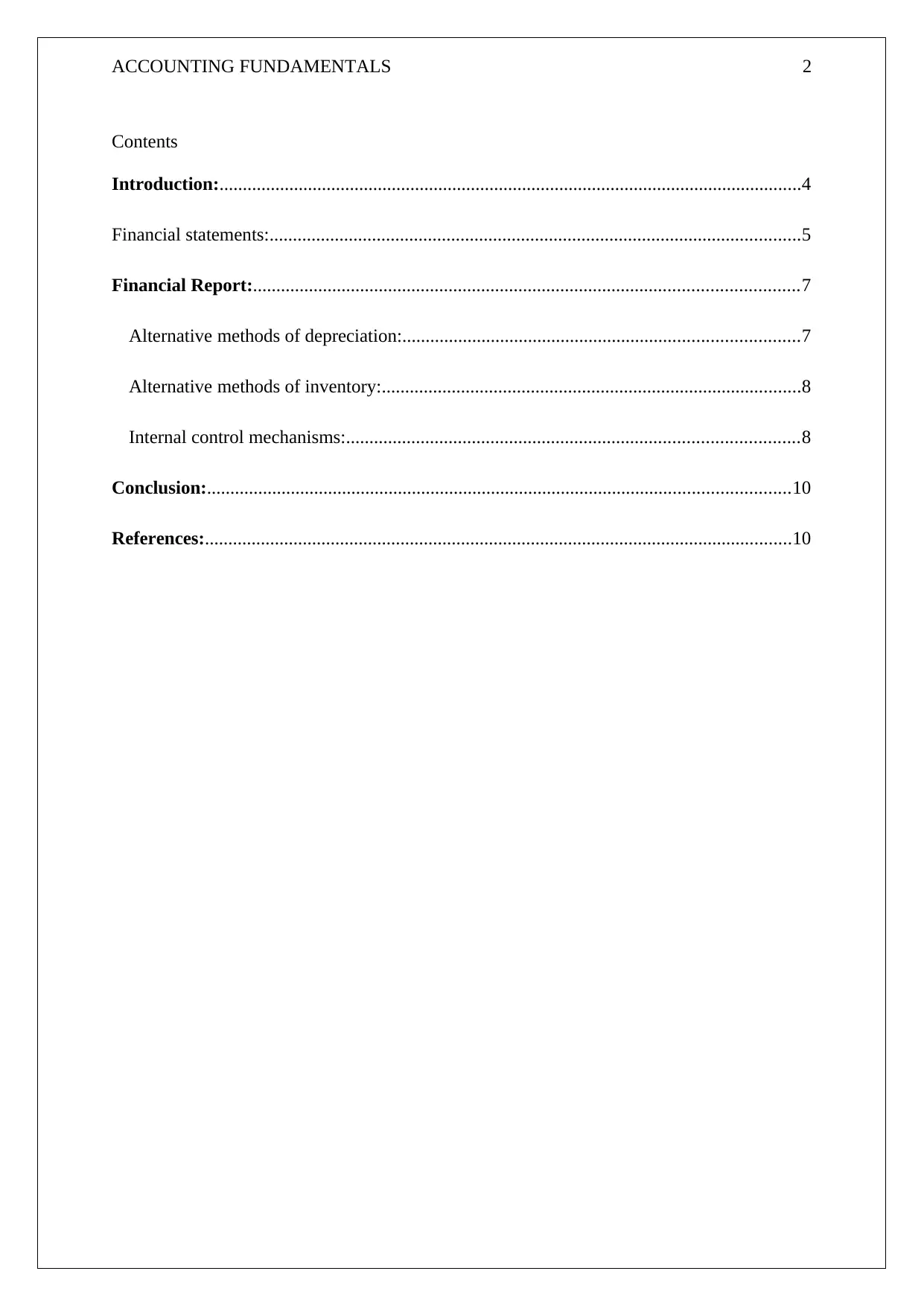
ACCOUNTING FUNDAMENTALS 2
Contents
Introduction:.............................................................................................................................4
Financial statements:..................................................................................................................5
Financial Report:.....................................................................................................................7
Alternative methods of depreciation:.....................................................................................7
Alternative methods of inventory:..........................................................................................8
Internal control mechanisms:.................................................................................................8
Conclusion:.............................................................................................................................10
References:..............................................................................................................................10
Contents
Introduction:.............................................................................................................................4
Financial statements:..................................................................................................................5
Financial Report:.....................................................................................................................7
Alternative methods of depreciation:.....................................................................................7
Alternative methods of inventory:..........................................................................................8
Internal control mechanisms:.................................................................................................8
Conclusion:.............................................................................................................................10
References:..............................................................................................................................10
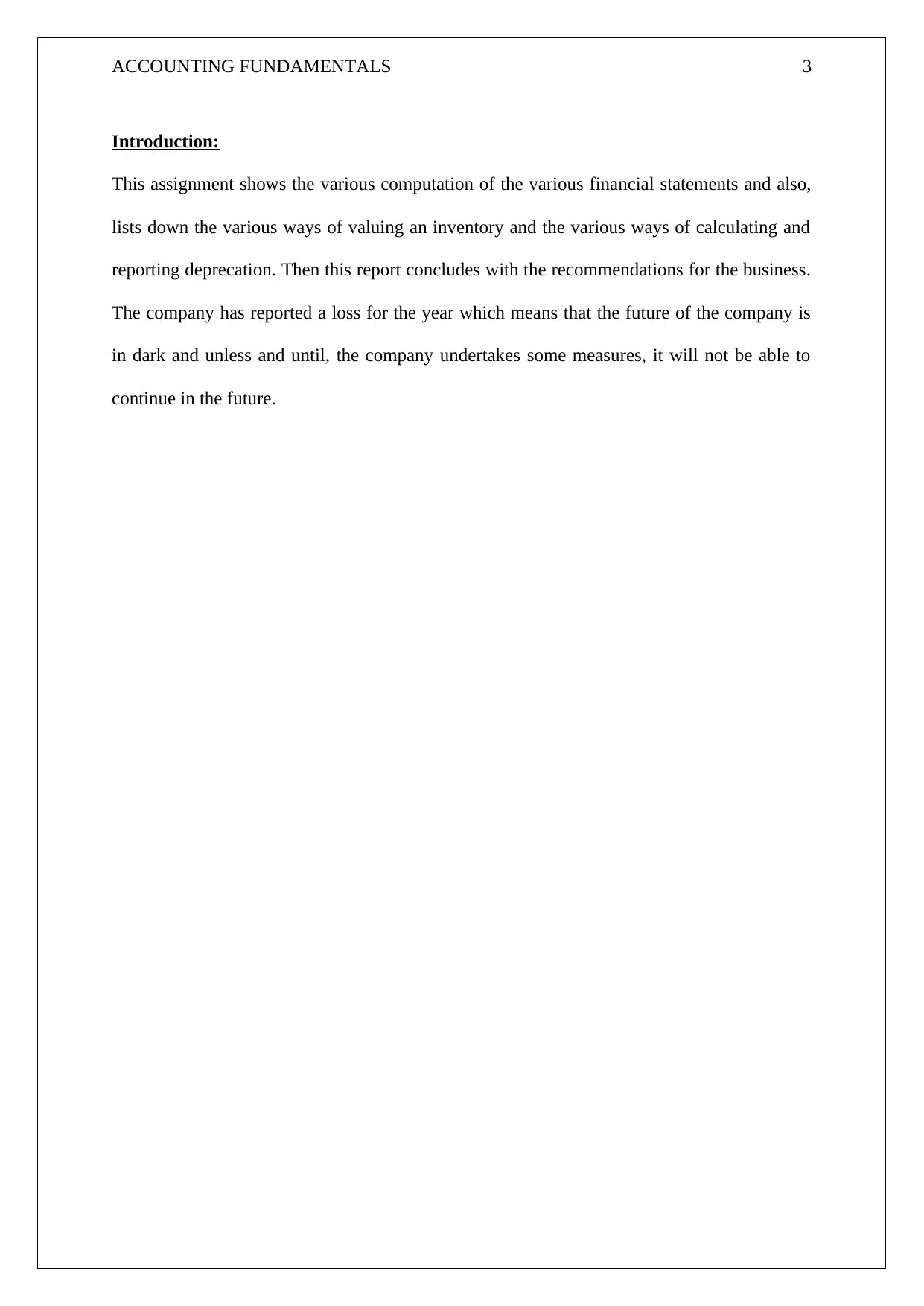
ACCOUNTING FUNDAMENTALS 3
Introduction:
This assignment shows the various computation of the various financial statements and also,
lists down the various ways of valuing an inventory and the various ways of calculating and
reporting deprecation. Then this report concludes with the recommendations for the business.
The company has reported a loss for the year which means that the future of the company is
in dark and unless and until, the company undertakes some measures, it will not be able to
continue in the future.
Introduction:
This assignment shows the various computation of the various financial statements and also,
lists down the various ways of valuing an inventory and the various ways of calculating and
reporting deprecation. Then this report concludes with the recommendations for the business.
The company has reported a loss for the year which means that the future of the company is
in dark and unless and until, the company undertakes some measures, it will not be able to
continue in the future.
⊘ This is a preview!⊘
Do you want full access?
Subscribe today to unlock all pages.

Trusted by 1+ million students worldwide
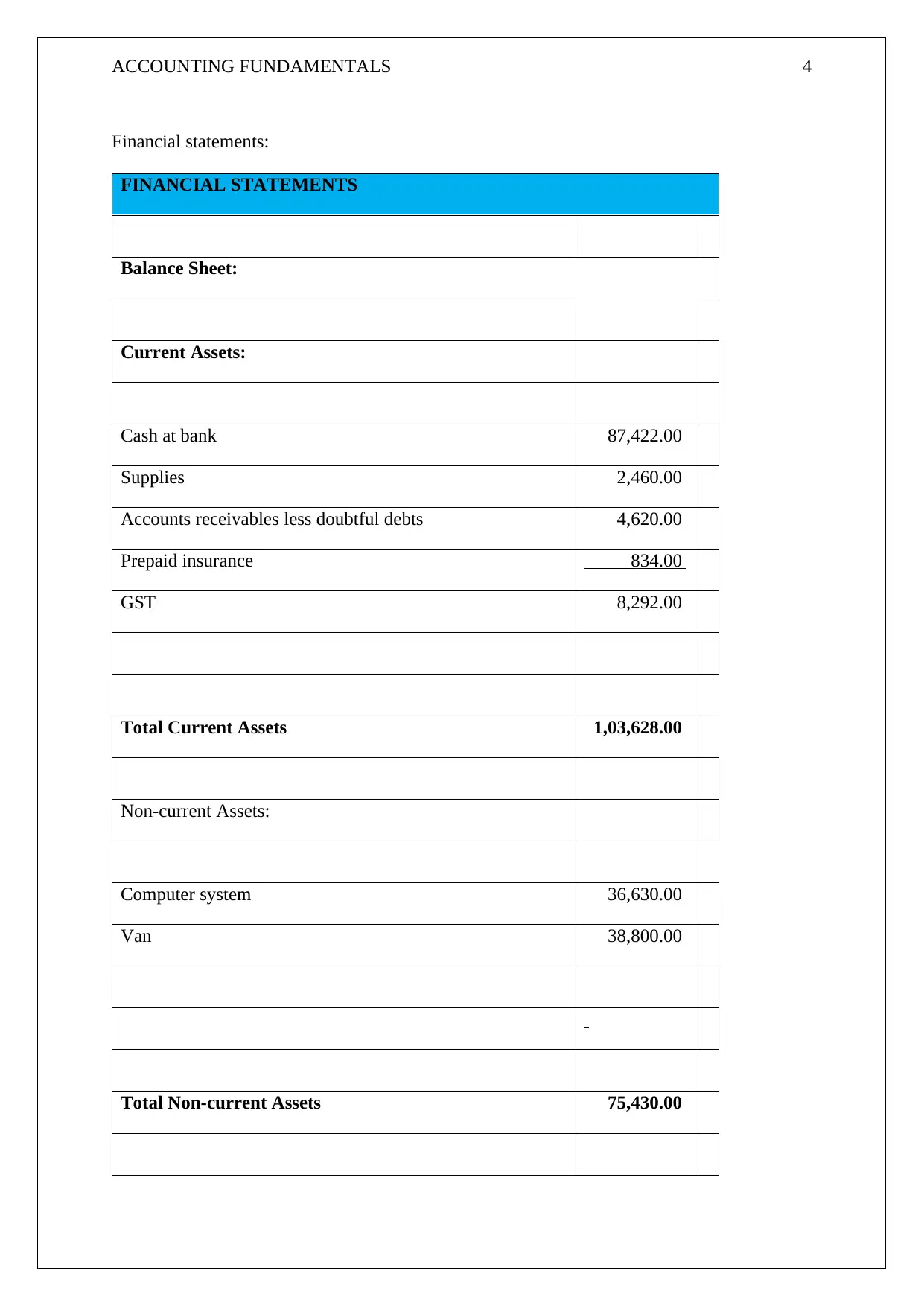
ACCOUNTING FUNDAMENTALS 4
Financial statements:
FINANCIAL STATEMENTS
Balance Sheet:
Current Assets:
Cash at bank 87,422.00
Supplies 2,460.00
Accounts receivables less doubtful debts 4,620.00
Prepaid insurance 834.00
GST 8,292.00
Total Current Assets 1,03,628.00
Non-current Assets:
Computer system 36,630.00
Van 38,800.00
Total Non-current Assets 75,430.00
Financial statements:
FINANCIAL STATEMENTS
Balance Sheet:
Current Assets:
Cash at bank 87,422.00
Supplies 2,460.00
Accounts receivables less doubtful debts 4,620.00
Prepaid insurance 834.00
GST 8,292.00
Total Current Assets 1,03,628.00
Non-current Assets:
Computer system 36,630.00
Van 38,800.00
Total Non-current Assets 75,430.00
Paraphrase This Document
Need a fresh take? Get an instant paraphrase of this document with our AI Paraphraser
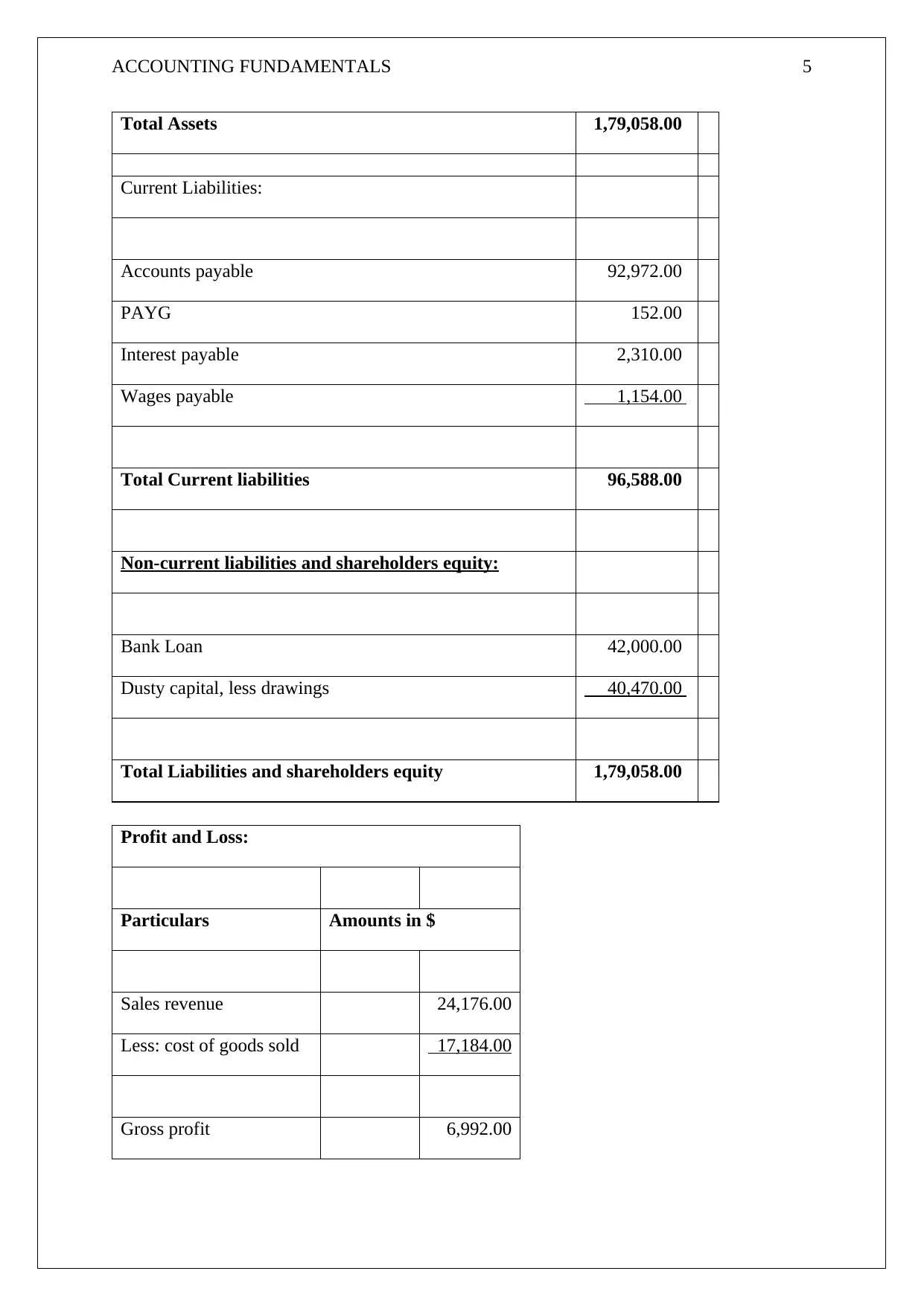
ACCOUNTING FUNDAMENTALS 5
Total Assets 1,79,058.00
Current Liabilities:
Accounts payable 92,972.00
PAYG 152.00
Interest payable 2,310.00
Wages payable 1,154.00
Total Current liabilities 96,588.00
Non-current liabilities and shareholders equity:
Bank Loan 42,000.00
Dusty capital, less drawings 40,470.00
Total Liabilities and shareholders equity 1,79,058.00
Profit and Loss:
Particulars Amounts in $
Sales revenue 24,176.00
Less: cost of goods sold 17,184.00
Gross profit 6,992.00
Total Assets 1,79,058.00
Current Liabilities:
Accounts payable 92,972.00
PAYG 152.00
Interest payable 2,310.00
Wages payable 1,154.00
Total Current liabilities 96,588.00
Non-current liabilities and shareholders equity:
Bank Loan 42,000.00
Dusty capital, less drawings 40,470.00
Total Liabilities and shareholders equity 1,79,058.00
Profit and Loss:
Particulars Amounts in $
Sales revenue 24,176.00
Less: cost of goods sold 17,184.00
Gross profit 6,992.00
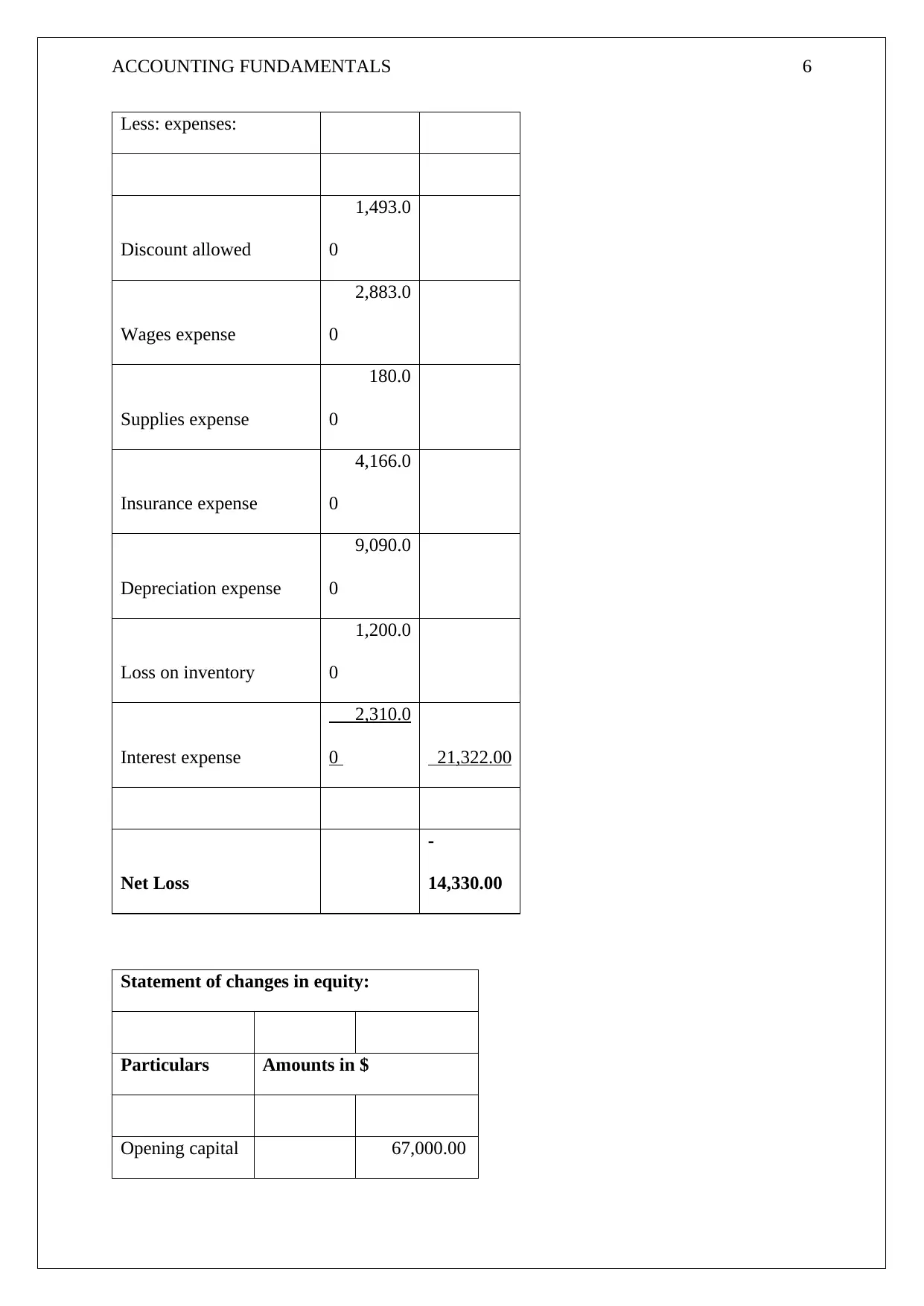
ACCOUNTING FUNDAMENTALS 6
Less: expenses:
Discount allowed
1,493.0
0
Wages expense
2,883.0
0
Supplies expense
180.0
0
Insurance expense
4,166.0
0
Depreciation expense
9,090.0
0
Loss on inventory
1,200.0
0
Interest expense
2,310.0
0 21,322.00
Net Loss
-
14,330.00
Statement of changes in equity:
Particulars Amounts in $
Opening capital 67,000.00
Less: expenses:
Discount allowed
1,493.0
0
Wages expense
2,883.0
0
Supplies expense
180.0
0
Insurance expense
4,166.0
0
Depreciation expense
9,090.0
0
Loss on inventory
1,200.0
0
Interest expense
2,310.0
0 21,322.00
Net Loss
-
14,330.00
Statement of changes in equity:
Particulars Amounts in $
Opening capital 67,000.00
⊘ This is a preview!⊘
Do you want full access?
Subscribe today to unlock all pages.

Trusted by 1+ million students worldwide
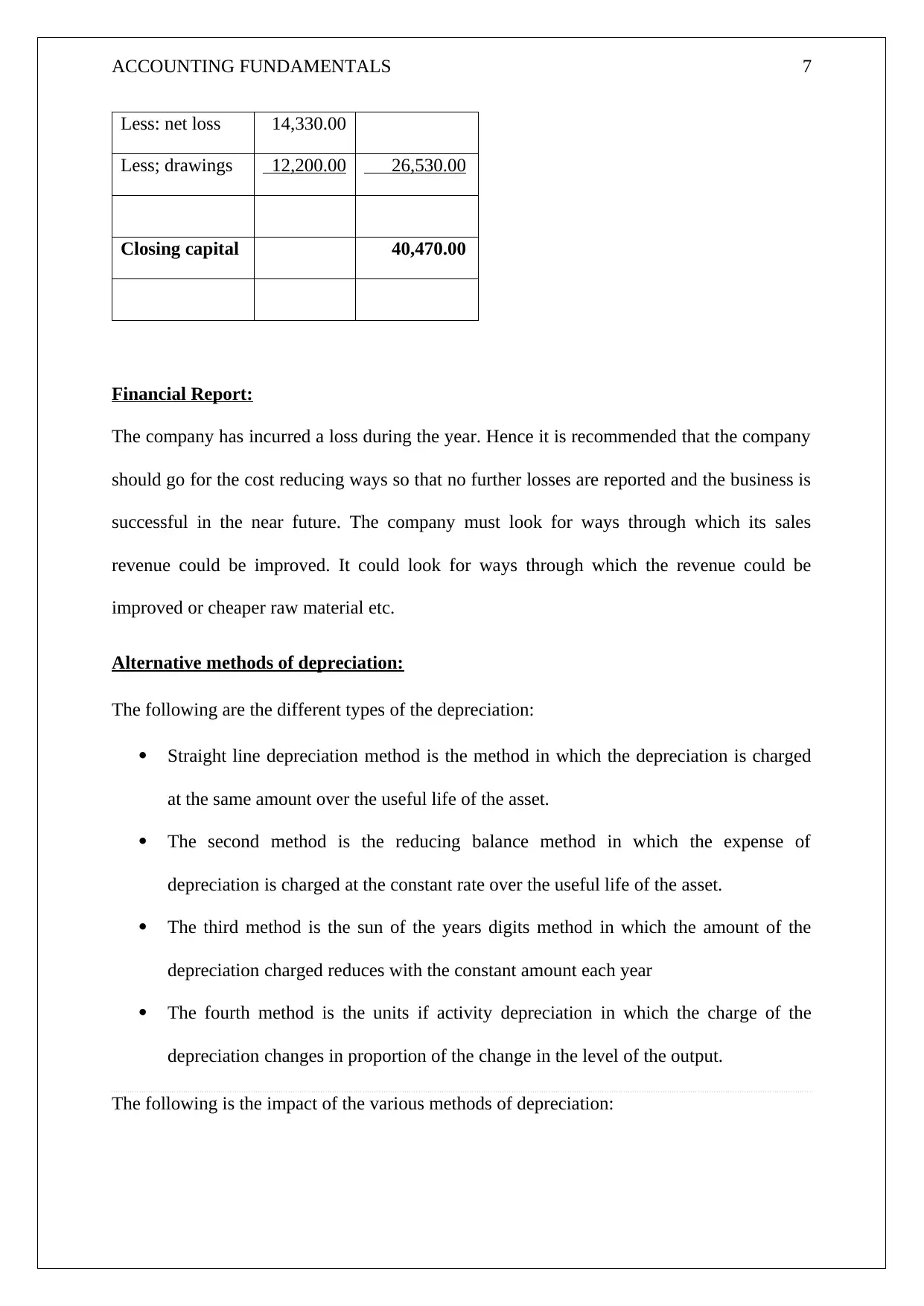
ACCOUNTING FUNDAMENTALS 7
Less: net loss 14,330.00
Less; drawings 12,200.00 26,530.00
Closing capital 40,470.00
Financial Report:
The company has incurred a loss during the year. Hence it is recommended that the company
should go for the cost reducing ways so that no further losses are reported and the business is
successful in the near future. The company must look for ways through which its sales
revenue could be improved. It could look for ways through which the revenue could be
improved or cheaper raw material etc.
Alternative methods of depreciation:
The following are the different types of the depreciation:
Straight line depreciation method is the method in which the depreciation is charged
at the same amount over the useful life of the asset.
The second method is the reducing balance method in which the expense of
depreciation is charged at the constant rate over the useful life of the asset.
The third method is the sun of the years digits method in which the amount of the
depreciation charged reduces with the constant amount each year
The fourth method is the units if activity depreciation in which the charge of the
depreciation changes in proportion of the change in the level of the output.
The following is the impact of the various methods of depreciation:
Less: net loss 14,330.00
Less; drawings 12,200.00 26,530.00
Closing capital 40,470.00
Financial Report:
The company has incurred a loss during the year. Hence it is recommended that the company
should go for the cost reducing ways so that no further losses are reported and the business is
successful in the near future. The company must look for ways through which its sales
revenue could be improved. It could look for ways through which the revenue could be
improved or cheaper raw material etc.
Alternative methods of depreciation:
The following are the different types of the depreciation:
Straight line depreciation method is the method in which the depreciation is charged
at the same amount over the useful life of the asset.
The second method is the reducing balance method in which the expense of
depreciation is charged at the constant rate over the useful life of the asset.
The third method is the sun of the years digits method in which the amount of the
depreciation charged reduces with the constant amount each year
The fourth method is the units if activity depreciation in which the charge of the
depreciation changes in proportion of the change in the level of the output.
The following is the impact of the various methods of depreciation:
Paraphrase This Document
Need a fresh take? Get an instant paraphrase of this document with our AI Paraphraser
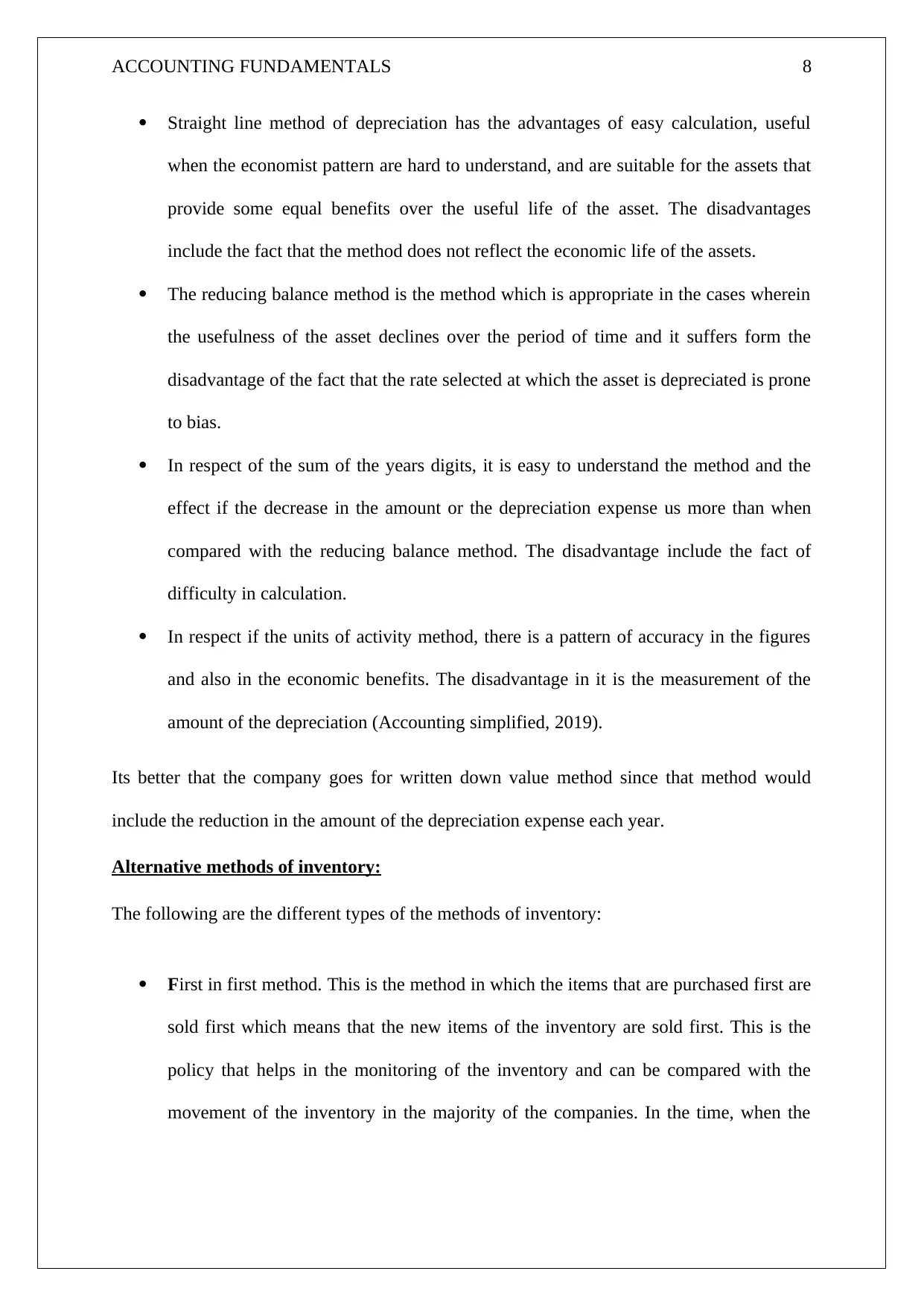
ACCOUNTING FUNDAMENTALS 8
Straight line method of depreciation has the advantages of easy calculation, useful
when the economist pattern are hard to understand, and are suitable for the assets that
provide some equal benefits over the useful life of the asset. The disadvantages
include the fact that the method does not reflect the economic life of the assets.
The reducing balance method is the method which is appropriate in the cases wherein
the usefulness of the asset declines over the period of time and it suffers form the
disadvantage of the fact that the rate selected at which the asset is depreciated is prone
to bias.
In respect of the sum of the years digits, it is easy to understand the method and the
effect if the decrease in the amount or the depreciation expense us more than when
compared with the reducing balance method. The disadvantage include the fact of
difficulty in calculation.
In respect if the units of activity method, there is a pattern of accuracy in the figures
and also in the economic benefits. The disadvantage in it is the measurement of the
amount of the depreciation (Accounting simplified, 2019).
Its better that the company goes for written down value method since that method would
include the reduction in the amount of the depreciation expense each year.
Alternative methods of inventory:
The following are the different types of the methods of inventory:
First in first method. This is the method in which the items that are purchased first are
sold first which means that the new items of the inventory are sold first. This is the
policy that helps in the monitoring of the inventory and can be compared with the
movement of the inventory in the majority of the companies. In the time, when the
Straight line method of depreciation has the advantages of easy calculation, useful
when the economist pattern are hard to understand, and are suitable for the assets that
provide some equal benefits over the useful life of the asset. The disadvantages
include the fact that the method does not reflect the economic life of the assets.
The reducing balance method is the method which is appropriate in the cases wherein
the usefulness of the asset declines over the period of time and it suffers form the
disadvantage of the fact that the rate selected at which the asset is depreciated is prone
to bias.
In respect of the sum of the years digits, it is easy to understand the method and the
effect if the decrease in the amount or the depreciation expense us more than when
compared with the reducing balance method. The disadvantage include the fact of
difficulty in calculation.
In respect if the units of activity method, there is a pattern of accuracy in the figures
and also in the economic benefits. The disadvantage in it is the measurement of the
amount of the depreciation (Accounting simplified, 2019).
Its better that the company goes for written down value method since that method would
include the reduction in the amount of the depreciation expense each year.
Alternative methods of inventory:
The following are the different types of the methods of inventory:
First in first method. This is the method in which the items that are purchased first are
sold first which means that the new items of the inventory are sold first. This is the
policy that helps in the monitoring of the inventory and can be compared with the
movement of the inventory in the majority of the companies. In the time, when the
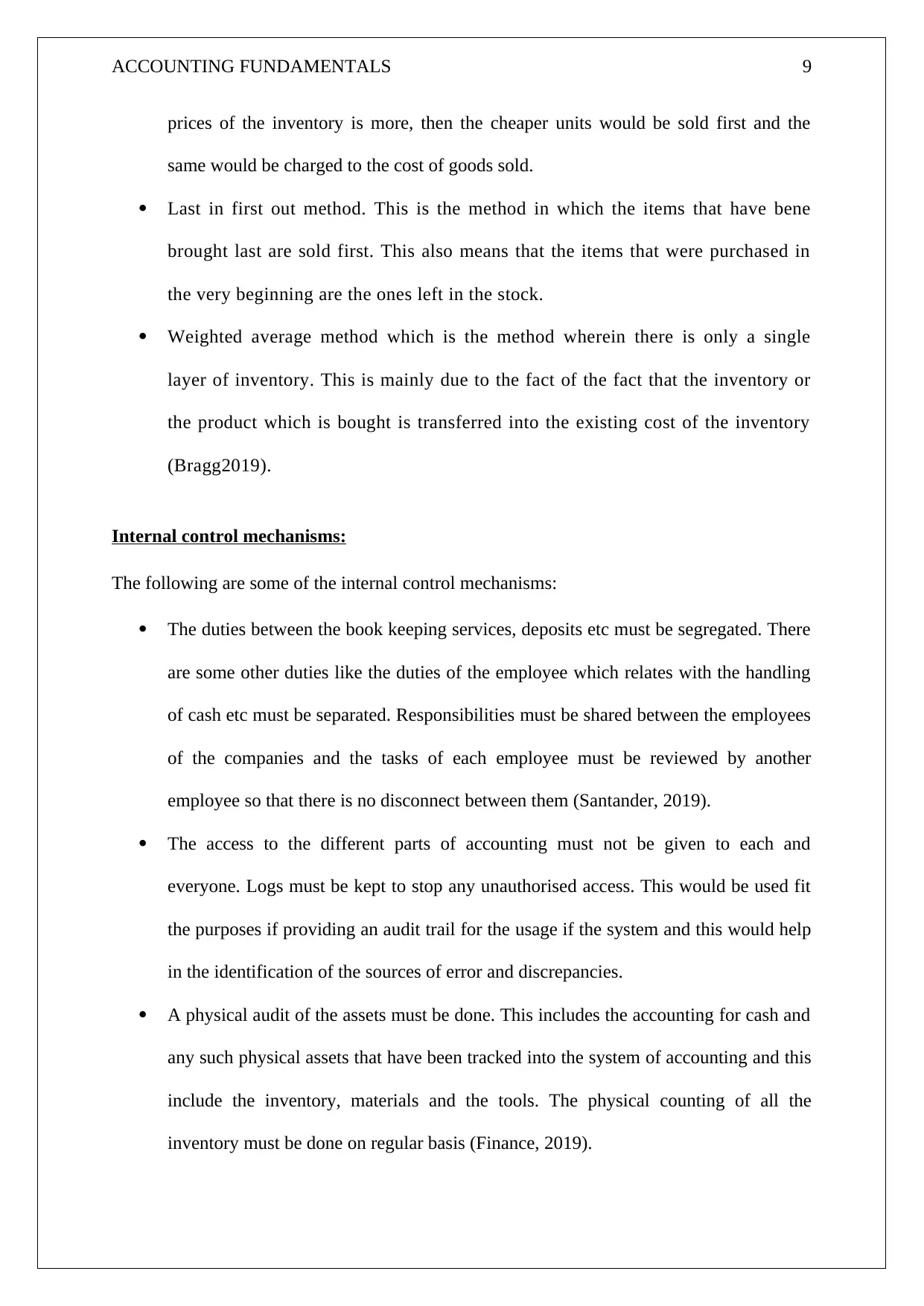
ACCOUNTING FUNDAMENTALS 9
prices of the inventory is more, then the cheaper units would be sold first and the
same would be charged to the cost of goods sold.
Last in first out method. This is the method in which the items that have bene
brought last are sold first. This also means that the items that were purchased in
the very beginning are the ones left in the stock.
Weighted average method which is the method wherein there is only a single
layer of inventory. This is mainly due to the fact of the fact that the inventory or
the product which is bought is transferred into the existing cost of the inventory
(Bragg2019).
Internal control mechanisms:
The following are some of the internal control mechanisms:
The duties between the book keeping services, deposits etc must be segregated. There
are some other duties like the duties of the employee which relates with the handling
of cash etc must be separated. Responsibilities must be shared between the employees
of the companies and the tasks of each employee must be reviewed by another
employee so that there is no disconnect between them (Santander, 2019).
The access to the different parts of accounting must not be given to each and
everyone. Logs must be kept to stop any unauthorised access. This would be used fit
the purposes if providing an audit trail for the usage if the system and this would help
in the identification of the sources of error and discrepancies.
A physical audit of the assets must be done. This includes the accounting for cash and
any such physical assets that have been tracked into the system of accounting and this
include the inventory, materials and the tools. The physical counting of all the
inventory must be done on regular basis (Finance, 2019).
prices of the inventory is more, then the cheaper units would be sold first and the
same would be charged to the cost of goods sold.
Last in first out method. This is the method in which the items that have bene
brought last are sold first. This also means that the items that were purchased in
the very beginning are the ones left in the stock.
Weighted average method which is the method wherein there is only a single
layer of inventory. This is mainly due to the fact of the fact that the inventory or
the product which is bought is transferred into the existing cost of the inventory
(Bragg2019).
Internal control mechanisms:
The following are some of the internal control mechanisms:
The duties between the book keeping services, deposits etc must be segregated. There
are some other duties like the duties of the employee which relates with the handling
of cash etc must be separated. Responsibilities must be shared between the employees
of the companies and the tasks of each employee must be reviewed by another
employee so that there is no disconnect between them (Santander, 2019).
The access to the different parts of accounting must not be given to each and
everyone. Logs must be kept to stop any unauthorised access. This would be used fit
the purposes if providing an audit trail for the usage if the system and this would help
in the identification of the sources of error and discrepancies.
A physical audit of the assets must be done. This includes the accounting for cash and
any such physical assets that have been tracked into the system of accounting and this
include the inventory, materials and the tools. The physical counting of all the
inventory must be done on regular basis (Finance, 2019).
⊘ This is a preview!⊘
Do you want full access?
Subscribe today to unlock all pages.

Trusted by 1+ million students worldwide
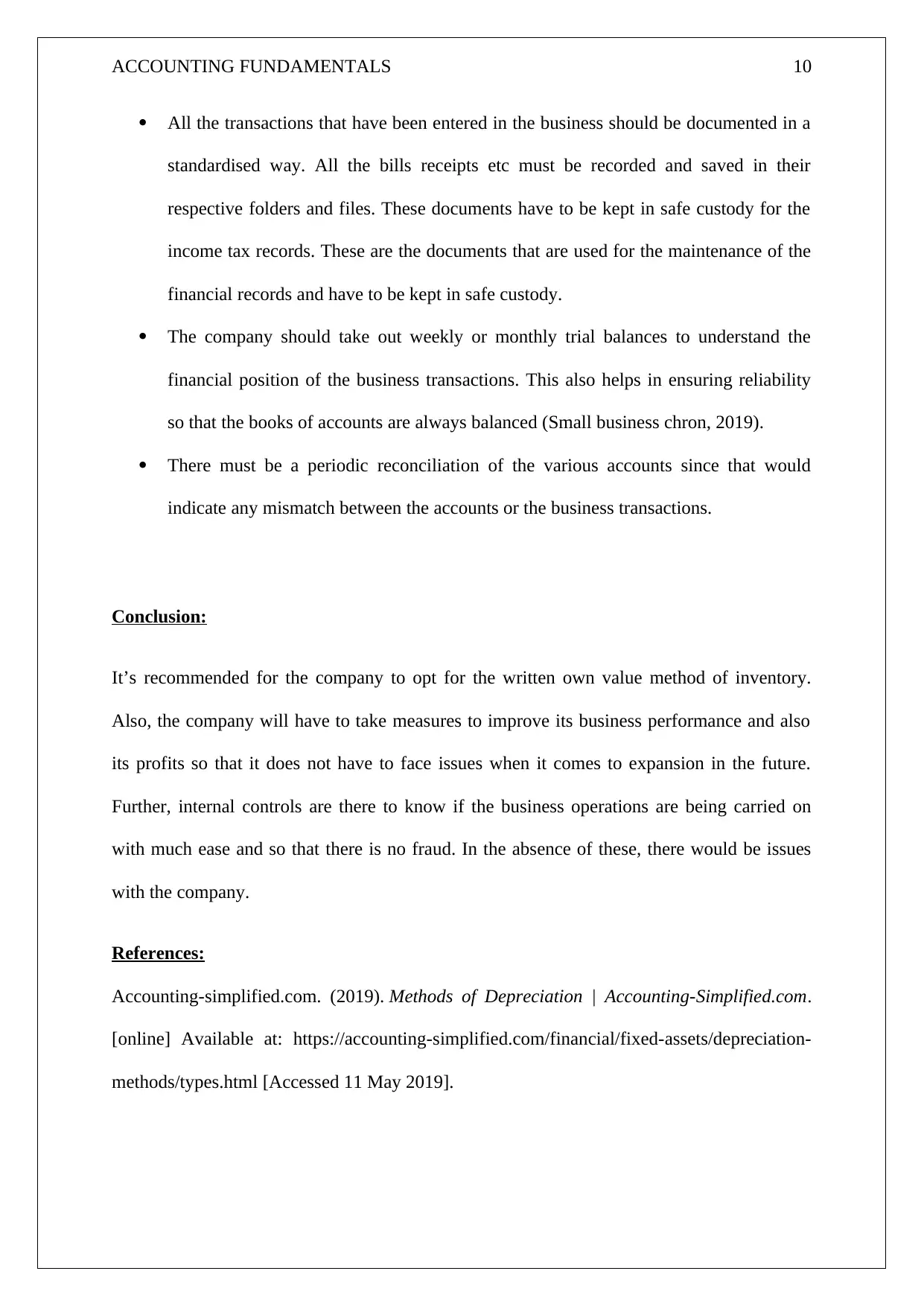
ACCOUNTING FUNDAMENTALS 10
All the transactions that have been entered in the business should be documented in a
standardised way. All the bills receipts etc must be recorded and saved in their
respective folders and files. These documents have to be kept in safe custody for the
income tax records. These are the documents that are used for the maintenance of the
financial records and have to be kept in safe custody.
The company should take out weekly or monthly trial balances to understand the
financial position of the business transactions. This also helps in ensuring reliability
so that the books of accounts are always balanced (Small business chron, 2019).
There must be a periodic reconciliation of the various accounts since that would
indicate any mismatch between the accounts or the business transactions.
Conclusion:
It’s recommended for the company to opt for the written own value method of inventory.
Also, the company will have to take measures to improve its business performance and also
its profits so that it does not have to face issues when it comes to expansion in the future.
Further, internal controls are there to know if the business operations are being carried on
with much ease and so that there is no fraud. In the absence of these, there would be issues
with the company.
References:
Accounting-simplified.com. (2019). Methods of Depreciation | Accounting-Simplified.com.
[online] Available at: https://accounting-simplified.com/financial/fixed-assets/depreciation-
methods/types.html [Accessed 11 May 2019].
All the transactions that have been entered in the business should be documented in a
standardised way. All the bills receipts etc must be recorded and saved in their
respective folders and files. These documents have to be kept in safe custody for the
income tax records. These are the documents that are used for the maintenance of the
financial records and have to be kept in safe custody.
The company should take out weekly or monthly trial balances to understand the
financial position of the business transactions. This also helps in ensuring reliability
so that the books of accounts are always balanced (Small business chron, 2019).
There must be a periodic reconciliation of the various accounts since that would
indicate any mismatch between the accounts or the business transactions.
Conclusion:
It’s recommended for the company to opt for the written own value method of inventory.
Also, the company will have to take measures to improve its business performance and also
its profits so that it does not have to face issues when it comes to expansion in the future.
Further, internal controls are there to know if the business operations are being carried on
with much ease and so that there is no fraud. In the absence of these, there would be issues
with the company.
References:
Accounting-simplified.com. (2019). Methods of Depreciation | Accounting-Simplified.com.
[online] Available at: https://accounting-simplified.com/financial/fixed-assets/depreciation-
methods/types.html [Accessed 11 May 2019].
Paraphrase This Document
Need a fresh take? Get an instant paraphrase of this document with our AI Paraphraser
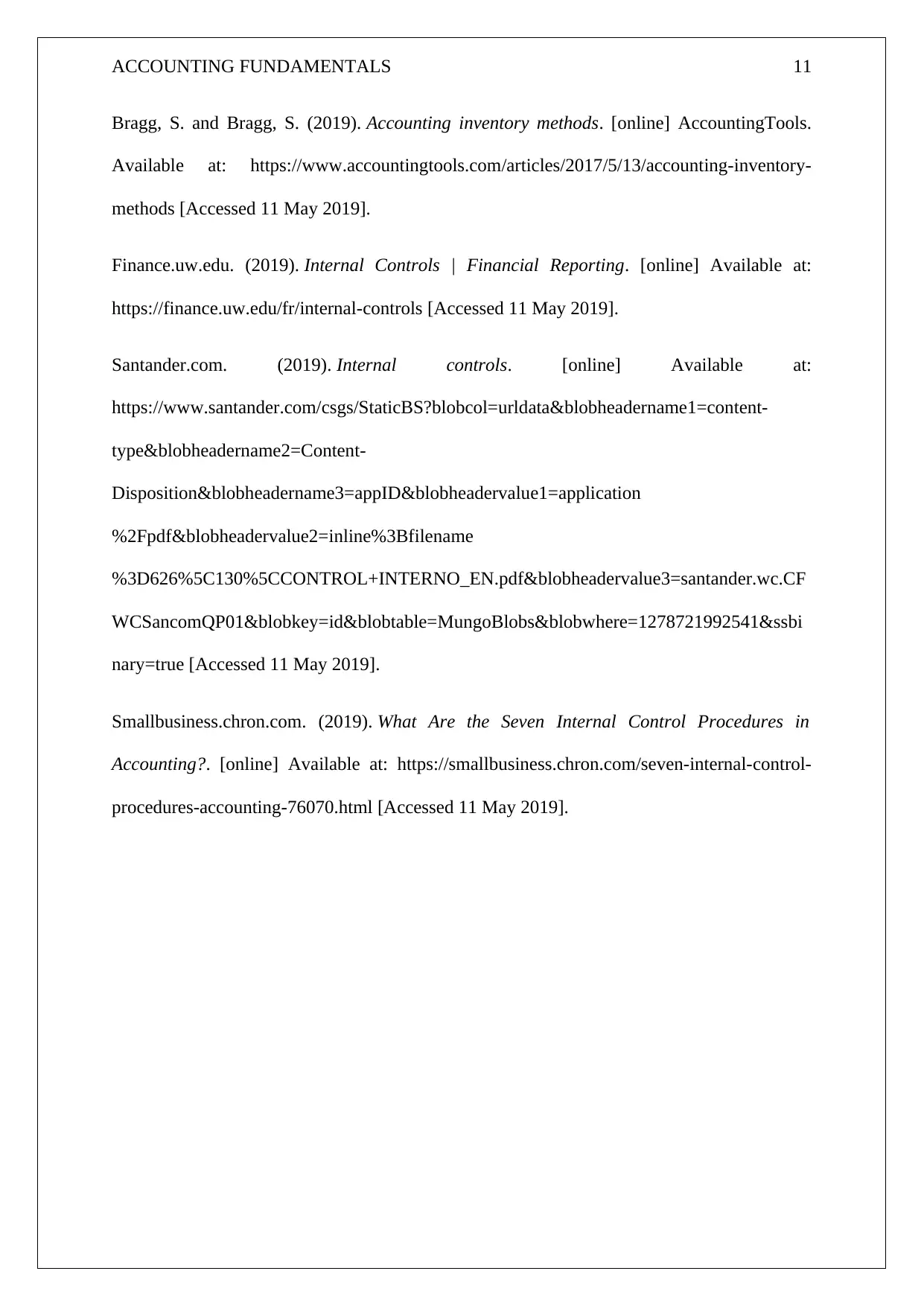
ACCOUNTING FUNDAMENTALS 11
Bragg, S. and Bragg, S. (2019). Accounting inventory methods. [online] AccountingTools.
Available at: https://www.accountingtools.com/articles/2017/5/13/accounting-inventory-
methods [Accessed 11 May 2019].
Finance.uw.edu. (2019). Internal Controls | Financial Reporting. [online] Available at:
https://finance.uw.edu/fr/internal-controls [Accessed 11 May 2019].
Santander.com. (2019). Internal controls. [online] Available at:
https://www.santander.com/csgs/StaticBS?blobcol=urldata&blobheadername1=content-
type&blobheadername2=Content-
Disposition&blobheadername3=appID&blobheadervalue1=application
%2Fpdf&blobheadervalue2=inline%3Bfilename
%3D626%5C130%5CCONTROL+INTERNO_EN.pdf&blobheadervalue3=santander.wc.CF
WCSancomQP01&blobkey=id&blobtable=MungoBlobs&blobwhere=1278721992541&ssbi
nary=true [Accessed 11 May 2019].
Smallbusiness.chron.com. (2019). What Are the Seven Internal Control Procedures in
Accounting?. [online] Available at: https://smallbusiness.chron.com/seven-internal-control-
procedures-accounting-76070.html [Accessed 11 May 2019].
Bragg, S. and Bragg, S. (2019). Accounting inventory methods. [online] AccountingTools.
Available at: https://www.accountingtools.com/articles/2017/5/13/accounting-inventory-
methods [Accessed 11 May 2019].
Finance.uw.edu. (2019). Internal Controls | Financial Reporting. [online] Available at:
https://finance.uw.edu/fr/internal-controls [Accessed 11 May 2019].
Santander.com. (2019). Internal controls. [online] Available at:
https://www.santander.com/csgs/StaticBS?blobcol=urldata&blobheadername1=content-
type&blobheadername2=Content-
Disposition&blobheadername3=appID&blobheadervalue1=application
%2Fpdf&blobheadervalue2=inline%3Bfilename
%3D626%5C130%5CCONTROL+INTERNO_EN.pdf&blobheadervalue3=santander.wc.CF
WCSancomQP01&blobkey=id&blobtable=MungoBlobs&blobwhere=1278721992541&ssbi
nary=true [Accessed 11 May 2019].
Smallbusiness.chron.com. (2019). What Are the Seven Internal Control Procedures in
Accounting?. [online] Available at: https://smallbusiness.chron.com/seven-internal-control-
procedures-accounting-76070.html [Accessed 11 May 2019].
1 out of 11
Related Documents
Your All-in-One AI-Powered Toolkit for Academic Success.
+13062052269
info@desklib.com
Available 24*7 on WhatsApp / Email
![[object Object]](/_next/static/media/star-bottom.7253800d.svg)
Unlock your academic potential
Copyright © 2020–2025 A2Z Services. All Rights Reserved. Developed and managed by ZUCOL.





